Third-Party Investigation Urged for Recent Bridge Collapses in Bihar | Patna News – Times of India

Patna: The recent collapse of five bridges in Bihar within a span of 12 days has raised serious concerns and sparked speculation among some members of the ruling NDA about a potential conspiracy to tarnish the image of the state govt led by CM Nitish Kumar.
This alarming situation has also worried retired senior engineers associated with the Bihar Engineering Services Association (BESA), with one member expressing apprehension about the possibility of more bridge collapses during the upcoming monsoon season when rivers are in spate.
The first major bridge collapse this year occurred on March 24, involving the country’s longest under-construction bridge spanning 10km across the Kosi river. The high-value bridge, worth Rs 1,700 crore and part of the central govt’s Bharatmala project, is located between Bheja and Bakaur in Madhubani and Supaul districts, respectively. The National Highway Authority of India (NHAI) promptly dispatched a three-member team to assess the situation and recommend remedial measures.
However, the same level of urgency has not been observed in the case of the five bridges that have collapsed in the last 12 days, with the latter four occurring in the last week of June. These bridges are located in Araria, Siwan, East Champaran (Motihari), Kishanganj, and Madhubani districts.
Retired chief engineer of the road construction department, Jai Kishore Dutt, suggests that instead of the usual reaction of ordering an inquiry or suspending lower-rung engineers, a third-party investigation and neutral assessment of the underlying causes should be conducted. Dutt emphasized the need to examine four key aspects: adherence to the approved design during implementation, quality control of work, use of project-specific standard materials in the correct proportion and size, and persistent supervision at the ground level.
An official from the road construction department, when contacted, declined to comment. In the past, supervision was carried out by junior engineers and executive engineers, but the situation has changed over the last decade.
For high-value bridges that yield substantial profits, supervision is now performed by consultant supervisors who are autonomous from the department’s engineers, as per the approved project. This shift has given a dominant position to the executing agency or private company.
A contractor, speaking on the condition of anonymity, revealed that this change has negatively influenced small executing agencies involved in the implementation of low-value bridge projects in the state.
“Junior engineers responsible for supervision and representatives of the work executing agency often form an unholy alliance, resulting in the use of substandard materials and violation of the prescribed ratio and size of cement, sand, steel rods, and concrete (chips). The quality of materials and measurements are compromised to maximize profits, with a portion of the gains being distributed as commission from the bottom up,” the contractor said.
This alarming situation has also worried retired senior engineers associated with the Bihar Engineering Services Association (BESA), with one member expressing apprehension about the possibility of more bridge collapses during the upcoming monsoon season when rivers are in spate.
The first major bridge collapse this year occurred on March 24, involving the country’s longest under-construction bridge spanning 10km across the Kosi river. The high-value bridge, worth Rs 1,700 crore and part of the central govt’s Bharatmala project, is located between Bheja and Bakaur in Madhubani and Supaul districts, respectively. The National Highway Authority of India (NHAI) promptly dispatched a three-member team to assess the situation and recommend remedial measures.
However, the same level of urgency has not been observed in the case of the five bridges that have collapsed in the last 12 days, with the latter four occurring in the last week of June. These bridges are located in Araria, Siwan, East Champaran (Motihari), Kishanganj, and Madhubani districts.
Retired chief engineer of the road construction department, Jai Kishore Dutt, suggests that instead of the usual reaction of ordering an inquiry or suspending lower-rung engineers, a third-party investigation and neutral assessment of the underlying causes should be conducted. Dutt emphasized the need to examine four key aspects: adherence to the approved design during implementation, quality control of work, use of project-specific standard materials in the correct proportion and size, and persistent supervision at the ground level.
An official from the road construction department, when contacted, declined to comment. In the past, supervision was carried out by junior engineers and executive engineers, but the situation has changed over the last decade.
For high-value bridges that yield substantial profits, supervision is now performed by consultant supervisors who are autonomous from the department’s engineers, as per the approved project. This shift has given a dominant position to the executing agency or private company.
A contractor, speaking on the condition of anonymity, revealed that this change has negatively influenced small executing agencies involved in the implementation of low-value bridge projects in the state.
“Junior engineers responsible for supervision and representatives of the work executing agency often form an unholy alliance, resulting in the use of substandard materials and violation of the prescribed ratio and size of cement, sand, steel rods, and concrete (chips). The quality of materials and measurements are compromised to maximize profits, with a portion of the gains being distributed as commission from the bottom up,” the contractor said.
















